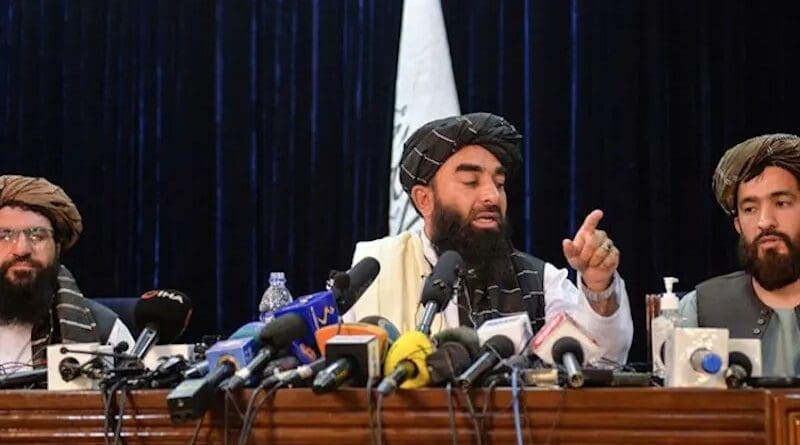What Does America Want? The Taliban Would Like To Know – OpEd
By James Durso
Afghanistan’s Taliban wants to work with neighboring countries to develop regional infrastructure projects, such as railways and electricity, but isn’t sure what is the clear U.S. position, as Washington has shifted its attention to Ukraine. Regional projects will need the U.S. to ease sanctions to help the region continue the economic recovery from the COVID pandemic and the disruption caused by NATO’s failed intervention in Afghanistan.
Will the U.S., having lost the military struggle, pivot to economic warfare to make life so intolerable that Afghan citizens eject the Taliban government? This myopic approach, on display when the U.S. froze Afghan Central Bank funds, would convince the world that the Potomac Panjandra learned nothing from that misadventure as the “success” of economic warfare would unleash even more misery and instability on the region.
Economic warfare didn’t work in Iraq as Saddam Hussein was ejected by the U.S. military, not aggrieved Iraqis, though it did manage to impoverish Iraq’s educated professional middle class leaving the country prey for Iran’s proxies and assorted militia leaders. Likewise, Iran’s leaders have proved ready to “eat grass” like their Pakistani counterparts when Islamabad developed nuclear weapons in the teeth of Western opposition.
The West’s opposition to the Kabul government has limited traction locally as it smells of anger and spite at being bested by goatherds with rifles, and promises that any negative consequences won’t (as usual) be felt in Washington.
In Kabul, interest centers on the proposed railway from Uzbekistan to Pakistan, and an electric power line from Uzbekistan to Afghanistan.
The 573-kilometer Mazar-e-Sharif–Kabul-Peshawar rail line, was announced by the respective capitals in February 2021 and will cost an estimated $4.8 billion, to be funded by international development banks. The line could move 10 million tons annually, and reduce shipping time by an estimated 30 percent.
The project would have to surmount engineering challenges from operating at up to 3,500 meters altitude, the incompatibility of the rail gauges used by the three countries, and difficulty recruiting skilled workers as well as training Afghans in the necessary trades. To complicate the politics, China has experience in high-altitude rail projects and may solicit a role in the project.
The Surkhan-Pul-e-Khumri power line is a 1,000 MW capacity line that would increase the supply of electricity from Uzbekistan to Afghanistan by 70 percent, up to 6 billion kWh per year. The cost of the project is $150 million, and the Asian Development Bank has pledged $70 million for the project, which was announced by the parties in February 2018. Despite delays caused by the NATO withdrawal from Afghanistan, the Uzbek and Afghan power authorities met in December 2021 about the resumption of the project. The Uzbek side announced it had completed the 45-km line from Surkhan to the Uzbek-Afghan border.
If the Surkhan-Pul-e-Khumri power line is a success, it may become part of the CASA-1000 project that will export power from Central Asia to South Asia, and is a step towards the Central Asia-South Asia Regional Electricity Market.
Also of interest to Kabul is access to the Iran’s Chabahar Port on the Gulf of Oman. Afghanistan has access to the port via Indian-funded Route 606 which connects Nimruz Province to the port via Iran’s road network and is shorter and more stable than the alternative route through Pakistan, which may not be available as relations between Kabul and Islamabad haven’t improved with the victory of the Pakistan-supported Taliban.
The rail line and power projects have suffered numerous delays and are on hold in the wake of the departure of the NATO forces. U.S. sanctions will make project participants wary of involvement unless and until they get Washington’s approval — and get it in writing. Another complication is the involvement of Iran’s sanctioned Islamic Revolutionary Guard Corps in the country’s ports and shipping.
Should the U.S. use regional economic projects as a way to start working with the Taliban?
The Taliban probably won’t flex on demands for liberal social policies or seating a “diverse” government acceptable to the West, and Washington’s fixation on punishing the Taliban will only enlist grudging local acceptance if it looks like revenge and not a way to get the region back on its feet after two decades of war. The primary goal should be to increase household incomes, which would benefit the Afghan women and girls the Americans are anxious to support, especially the estimated 2 million war widows who are also heads of households and arguably the most disenfranchised group in the country.SEC should strengthen required climate risk disclosuresWe will soon find out if FERC is serious about climate and environmental justice
The Russia-Ukraine war highlighted the vulnerability of the world’s supply chain to limited sources of critical industrial metals. Afghanistan has potentially 1.4 million tons of rare earth elements — and China has already secured rights to copper, coal, oil, and lithium deposits. The U.S. should support regional efforts to build secure transport routes and reliable power grids, both necessary for mining, and should encourage Western mining companies, such as Australia’s BHP and Britain’s Rio Tinto, to pursue opportunities in Afghanistan.
Washington can dip its toe in by working with Central and South Asian countries on regional projects that improve economic opportunity for all. While Washington expects the Taliban to prove its good intentions to the West by changing its policies by 180 degrees, Afghanistan’s neighbors will be looking to Washington to see if the Americans can move beyond anger over the failure of the Afghanistan project and start to think strategically about the region.
This article was published at The Hill

